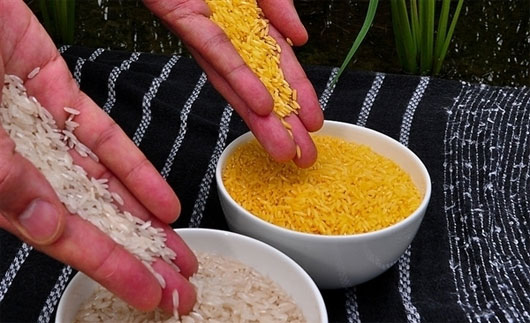New rice varieties supplement nutrition for poor children
The Philippines-based International Rice Research Institute (IRRI) is pushing for the pilot planting of a new variety of rice, believed to address the problem of vitamin A deficiency - the leading cause of blindness and deaths from infections in underdeveloped countries.
The World Health Organization (WHO) estimates that about 250 million children globally do not absorb enough vitamin A, with about 500,000 children blinded each year and 50% die within 1 year after losing sight."Golden rice" , named after the color of the rice grain, is the result of a genetic supplement that contains trace amounts of daffodils and part of the gene that produces beta-carotene and precursors. of vitamin A, from sweet corn varieties.

IRRI experts compare ordinary rice (left) with yellow rice.(Photo: Greenpeace)
The first "golden rice" science project - published in 2000 - is the result of research by Professor Ingo Potrykus of the Swiss Federal Institute of Technology and Dr. Peter Beyer of the University of Freiburg (Germany). malnutrition. In 2005, Switzerland's Syngenta Biotechnology Company said it produced 23 varieties of rice with beta-carotene ratio 23 times higher than the original. Later, Syngenta decided to transfer to IRRI in a humanitarian project.
In 2009, golden rice was tested clinically on five volunteers from Boston (USA), thereby showing that 100 grams of new rice can provide 70% of vitamin A needs for both men and women. Thereby, IRRI speculates that 50 grams of yellow rice can meet 60% of this nutrient requirement in children aged 4-8 years.
It is known that IRRI's Golden Rice Variety Trial Project received the support of charitable groups such as the Bill and Melinda Gates Foundation, Helen Keller International's Research, Health and Nutrition Research Foundation, the Rockefeller Foundation. and United States Agency for International Development (USAID). IRRI is expected to test animals with gold rice early next year, before testing its ability to supply vitamin A on humans.
- Discovering new rice varieties with antioxidant capacity
- Successful restoration of rice varieties Bao thai Cho Don
- Dong Thap: Successfully creating new rice varieties
- Japan finds a new rice variety that can withstand drought
- An Giang creates rice varieties that are flood-resistant and drought-resistant
- The technique to create rice varieties is higher than the head, yield 30 tons / ha
- Rice varieties with salinity and high yield
- China produces rice varieties higher than human heads for high productivity
- Vietnam successfully bred two high quality rice varieties
- Choose to create two new high quality aromatic rice varieties
- Cooking rice in a folk style makes it poor
- Phu Tho successfully tested many new rice varieties
 Why do potatoes have eyes?
Why do potatoes have eyes? 'Tragedy' the world's largest carnivorous life: Death becomes ... public toilet
'Tragedy' the world's largest carnivorous life: Death becomes ... public toilet Tomatoes were once considered 'poisonous' for 200 years
Tomatoes were once considered 'poisonous' for 200 years Detecting microscopic parasites on human face
Detecting microscopic parasites on human face